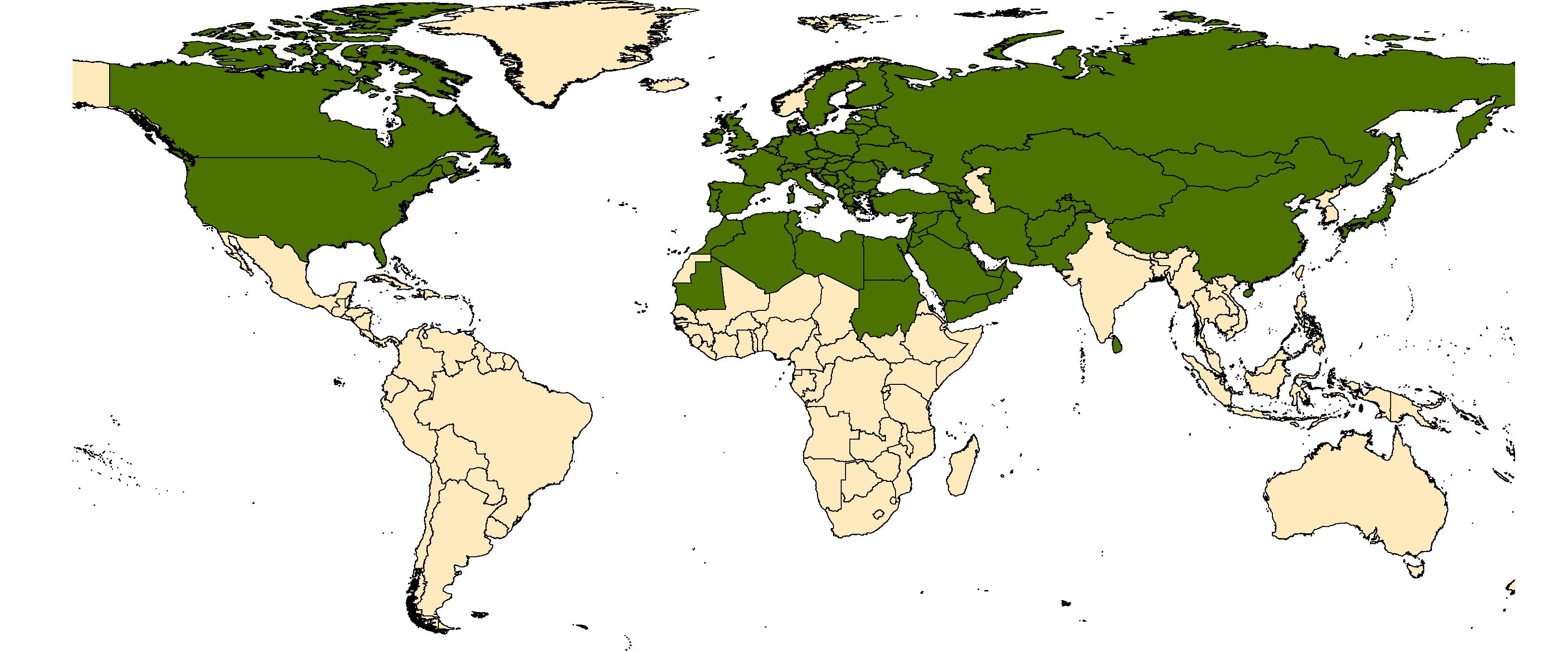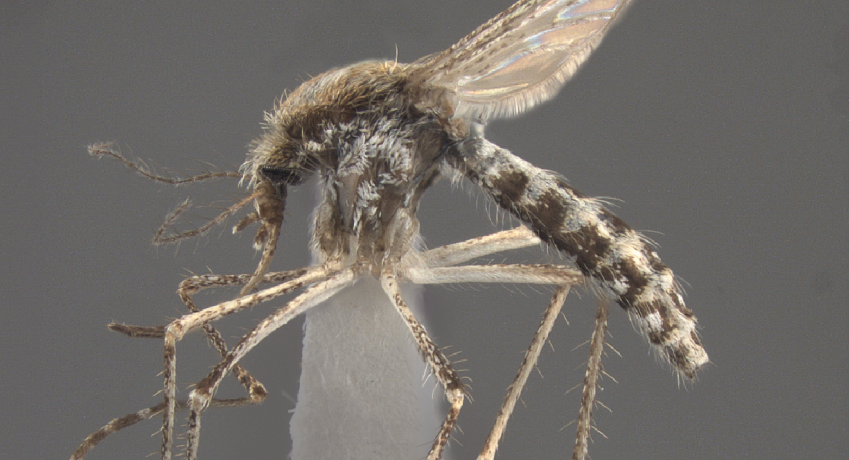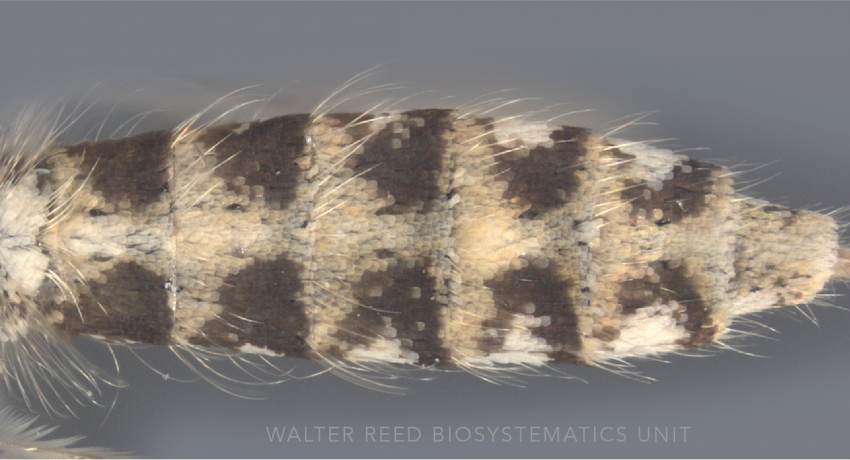PALEARCTIC & AFROTROPICAL REGIONS
Etymology: Caspian Sea
Aedes caspius is one of the most common mosquitoes found in many areas of Europe and the Middle East. It is the nominative species of the Caspius Group, which also includes the common Holarctic vector species Ae. dorsalis (Meigen). The species are sometimes sympatric, but overall Ae. caspius tends to be found in hotter, drier areas than Aedes dorsalis.
Type locality: Caspian Sea
Type depository: Type non-existent (NE)
DIAGNOSTIC CHARACTERS (Click photos to view; mouse over and click large photo to zoom in.)
ADULT (illustrated): Thorax: Scutum with golden scales and narrow dorsocentral lines of white scales. Abdomen: Terga with median pale stripe, or all pale-scaled. Wing: Speckled with dark and pale scales; costa predominantly dark-scaled. Leg: Ta-III1–4 with basal and apical bands.
LARVA (not illustrated): Head: Antenna usually uniformly spiculate; seta 1-A 3–12 branched. Terminal segments: 18–28 comb scales in a triangular patch; siphon with 1-S multi-branched; pecten with c. 20 spines reaching c. mid siphon.
TAXONOMIC KEYS
Darsie & Samandou-Voyadjoglou 1997
Samanidou-Voyadjoglou & Harbach 2001
Becker et al. 2010
Exemplar DNA sequences
Ae. caspius COI: AF253024–25, KM452948, KM457568-69, KP942727, KP942758, KT361854-55, KT634315, KT876464, KT876468, MH559350, MH634424–25.
BIONOMICS
Immatures
Aedes caspius immatures are found in a wide variety of shaded or unshaded coastal sites in the United Kingdom, and in saline lakes and pools around the Mediterranean. In the remainder of its range, it is found in both fresh and saline marshes, but is most abundant in salt marshes.
Adults
Aedes caspius is a floodwater mosquito, passing the winters in colder climates as eggs than emerge upon inundation in the spring. Like other salt marsh mosquitoes, females often make long-distance flights shortly after emergence. Some Ae. caspius populations are autogenous, able to deposit one batch of eggs prior to the first blood meal. Aedes caspius pass multiple generations per year and can become a significant nuisance when abundant, biting day and night, both indoors and out. At lower population levels, biting usually occurs outdoors during crepuscular periods. It is one of the only mosquitoes proven to transmit Francisella tularensis, the causative agent of tularemia.
DISTRIBUTION NOTES
Afghanistan, Albania, Algeria, Armenia, Austria, Azerbaijan, Bahrain, Belarus, Belgium, Bosnia & Herzegovina, Bulgaria, Canada, Croatia, Cyprus, Czech Republic, Denmark, Djibouti, Egypt, Estonia, Finland, France, FYRO Macedonia, Georgia, Germany, Greece, Hungary, Iran, Iraq, Ireland, Israel (and Gaza Strip & West Bank), Italy (includes Sardinia & Sicily), Japan, Jordan, Kazakhstan, Kosovo, Kuwait, Latvia, Lebanon, Libya, Lithuania, Malta, Mauritania, Moldova, Mongolia, Montenegro, Morocco, Netherlands, Norway, Pakistan, Palestine, People's Republic of China, Poland, Portugal, Qatar, Romania, Russia (Northwestern, Central, Southern & Volga Districts), Saudi Arabia, Serbia, Slovakia, Slovenia, Spain (includes Balearic & Canary Islands), Sri Lanka, Sudan & South Sudan, Sweden, Switzerland, Tajikistan, Tunisia, Turkey, Turkmenistan, Ukraine, United Arab Emirates, United Kingdom, United States, Uzbekistan, Yemen.

WRBU VECTOR HAZARD REPORTS
VHR: Medically Important Mosquitoes of EUCOM
View other WRBU Vector Hazard Reports
Available GIS Models
None
IMPORTANT REFERENCES (full citations below)
Pallas 1771: 574 (A; as Culex)
Kirkpatrick 1925b: 79 (M*, F*, P*, L*; bionomics)
Barraud 1934: 148 (M*, F, P, L)
Marshall 1938 (E*)
Clavero 1946: 8 (M*, F*, L*)
Natvig 1948: 211 (M*, F*, L*; bionomics), 202 (taxonomy)
Senevet et al. 1949 (aberrant M*)
Monchadskii 1951: 160, 164 (L*; taxonomy)
Hopkins 1952: 125 (L*)
Mattingly & Knight 1956: 98 (taxonomy)
Richards 1956: 264 (M*, F*, L*)
Nielsen & Nielsen 1958: 282 (bionomics)
Senevet & Andarelli 1958: 279 (P*)
Abul-Hab 1967: 279 (distribution)
Aslamkhan 1971b (distribution; Pakistan)
Minar 1971 (distribution)
Rjazantzeva 1972 (F*)
Gutsevich et al. 1974: 197 (M, F, L*)
Minar 1976: 344 (M*, F*; taxonomy)
Utrio 1976: 131, 134 (L*)
Gutsevich 1976: 48 (polymorphism)
Rodhain et al. 1977 (distribution)
Moussiegt 1981 (complete annotated bibliography)
Zaim 1987 (distribution)
Moussiegt 1988b (complete annotated bibliography)
Lambert et al. 1990 (E*)
Mgeladze 1991: 329 (distribution; Georgia)
Linley et al. 1993c (E*)
Suleman et al. 1993 (distribution; Pakistan)
Abdullah & Merdan 1995 (distribution; Saudi Arabia)
Amr et al. 1997 (distribution; Jordan)
Darsie & Samanidou-Voyadjoglou 1997 (keys)
Alten et al. 2000 (distribution; Turkey)
Eritja et al. 2000: 11 (distribution)
Hadjivassilis 2000 7: 38 (distribution; Cyprus)
Spungis 2000 (distribution; Latvia)
Samanidou-Voyadjoglou & Harbach 2001 (key)
Trari et al. 2002 (distribution; Morocco)
Milankov et al. 2009 (taxonomy, bionomics, review)
Osório et al. 2010 (distribution, Portugal)
Becker et al. 2010: 216 (M*, F*, L*; keys, taxonomy, distribution, bionomics)
Ahmed et al. 2011 (distribution; Saudi Arabia)
Namazov 2014 (distribution; Azerbaijan)
Robert et al. 2019 (distribution, Euro-Mediterranean)
CURRENT SYNONYMS
syn. punctatus Meigen
1804: 6 (M, F; Culex). Type locality: Aden (MNHP).
syn. siculus Robineau-Desvoidy
1827: 406 (M, F; Culex). Type locality: Sicily [Italy] (NE).
syn. maculiventris Macquart
1846a : 135 (F; Culex). Type locality: Algeria (MNHP).
syn. penicillaris Rondani
1872: 31 (A; Culex). Type locality: Italy (LU).
syn. curriei Coquillett
1901: 259 (F; Culex). Type locality: Boise, Idaho, United States (USNM). References: Stone & Knight 1956a: 216 (type information).
syn. onondagensis Felt
1904: 304 (F*; Culex). Type locality: Lake Onondaga, Syracuse, New York, United States (NY). References: Howard et al. 1917: 629 (M, F, L*).
syn. longisquamosa Theobald
1905f: 103 (F*; Grabhamia). Type locality: Sousse, Tunis [Tunisia] (HNM). References Edwards 1921d: 299 (synonymy).
syn. subtilis Sergent & Sergent
1905: 673 (Apr. 14) (A, L; Grabhamia). Type locality: Biskra [Constantine], Algeria (LU).
syn. lativittatus Coquillett
1906c: 109 (A; Culex). Type locality: Arden, Alameda County, California, United States (USNM). References: Stone & Knight 1956a: 220 (type information, lectotype designation).
syn. arabica Giles
1906: 130 (M, F; Mansonia). Type locality: Bahrain, Persian Gulf (NHMUK).
syn. quaylei Dyar & Knab
1906d: 202 (A). /span>Type locality: California, United States (NE). References: Stone & Knight 1956a: 224 (type information).
syn. africanus Neveu-Lemaire
1906: 271 (F*; Taeniorhynchus). Type locality: Port Said, Suez & Cairo [Egypt] (NE).
syn. willcocksii Theobald
1907: 296 (M*, F*; Grabhamia). Type locality: Kafr el Dawar, Egypt (NHMUK).
syn. arabicus Becker
1910: 140 (F; Culex). Type locality: Ras Shoab, Socotra [Yemen] (ZM).
ssp. hargreavesi Edwards
1920a: 130 (F; as Aedes). Type locality: Taranto [Puglia], Italy (NHMUK). Distribution: France, Italy. References: Harbach & Howard 2007: 43 (to subspecies). Etymology: E. Hargreaves.
syn. broquetii Theobald
1913c: 179 (F; Grabhamia). Type locality: Tet-chili, northern China & Tamsui, Formosa [Taiwan, ROC] (NHMUK & GDZ).
syn. grahami Ludlow
1920(1919)a: 154 (M, F). Type locality: Mostovoi, Siberia [USSR] (USNM). References: Stone & Knight 1956a: 218 (type information, lectotype designation).
syn. epsilonn Séguy
1924: Pl. XXIII, 97 (L*). Type locality: Region de Djamaa, Tiguedidine [Touggourt], Algeria (NE). References: Monchadskii 1951: 160 (synonymy).
ssp. meirai Ribeiro, Ramos, Capela & Pires
1980: 69 (M, F, L, P; as Aedes (Ochlerotatus)). Type locality: Curral Velho, Ilha da Boa Vista, Cape Verde (IHMT). Distribution: Cape Verde. Etymology: Manuel T.V. de Meira.
CITED REFERENCES
Ahmed, A.M., Shaalan, E.A., Aboul-Soud, M.A.M., Tripet, F., & Al-Khedhairy, A.A. (2011). Mosquito vectors survey in the Al-Ahsaa district of eastern Saudi Arabia. Journal of Insect Science, 11, 176.
Abdullah, M.A.R., & Merdan, A.I. (1995). Distribution and ecology of the mosquito fauna in the southwestern Saudi Arabia. Journal of the Egyptian Society of Parasitology, 25(3), 815–837.
Abul-Hab, J. (1967). Larvae of culicine mosquitos in north Iraq (Diptera, Culicidae). Bulletin of Entomological Research, 57(2), 279–284.
Alten, B., Caglar, S.S., & Ozer, N. (2000). Malaria and its vectors in Turkey. European Mosquito Bulletin, 7, 27–33.
Amr, Z.S., Al-Khalili, Y.H., & Arbaji, A. (1997). Larval mosquitoes collected from northern Jordan and the Jordan Valley. Journal of the American Mosquito Control Association, 13(4), 375–378.
Aslamkhan, M. (1971b). The mosquitoes of Pakistan I. A checklist. Mosquito Systematics, 3(4), 147–159.
Barraud, P. J. (1934). The fauna of British India, including Ceylon and Burma. Diptera. Vol. 5. Family Culicidae, tribes Megarhinini and Culicini (Vol. 5). London: Taylor and Francis.
Becker, N., Petrić, D., Zgomba, M., Boase, C., Madon, M., Dahl, C., & Kaiser, A. (2010). Mosquitoes and their control (Second ed.). Berlin Heidelberg: Springer-Verlag.
Becker, T. (1910). Dipteren aus Südarabien und von der Insel Sokótra. Wien: Aus der Kaiserlich-Königlichen Hof-und Staatsdruckerei, 71(2), 131–160.
Clavero, G. (1946). Aedinos de España. Revista de Sanidad e Higiene Pública, 20, 1–28.
Coquillett, D.W. (1901). Three new species of Culicidae. Canadian Entomologist, 33, 258–260.
Coquillett, D.W. (1906c). Synoptic tables of the North American mosquitoes. Entomological News, 17, 109.
Darsie, R.F., Jr., & Samanidou-Voyadjoglou, A. (1997). Keys for the identification of the mosquitoes of Greece. Journal of the American Mosquito Control Association, 13(3), 247–254.
Dyar, H.G., & Knab, F. (1906d). The larvae of Culicidae classified as independent organisms. Journal of the New York Entomological Society, 14, 169–230.
Edwards, F.W. (1920a). Mosquito notes. Bulletin of Entomological Research, 10, 129–137.
Eritja, R., Aranda, C., Padrós, J., Goula, M., Lucientes, J., Escosa, R., . . . Cáceres, F. (2000). An annotated checklist and bibliography of the mosquitoes of Spain (Diptera: Culicidae). European Mosquito Bulletin, 8, 10–18.
Felt, E.P. (1904). Mosquitos or Culicidae of New York State. Bulletin of the New York State Museum, 79, 241–400.
Giles, G.M. (1906). Mosquito notes. I. Note on a small collection of mosquitoes from Bahrain in Northern Arabia (shores of Persian Gulf). Journal of Tropical Medicine, 9, 130–132.
Gutsevich, A.V. (1976). On polytypical species of mosquitoes (Diptera, Culicidae). I. Anopheles hyrcanus (Pallas, 1771). Parazitologiya (St. Petersburg), 10(2), 148–153.
Gutsevich, A.V., Monchadskii, A.S., & Shtakel’berg, A.A. (1974). Fauna of the USSR. New series No. 100 Diptera. Vol. III, No. 4. Mosquitoes. Family Culicidae. Jerusalem, Israel: Keter Publishing House Jerusalem Ltd. (Original work published 1971).
Hadjivassilis, A. (2000). Mosquitoes (Diptera: Culicidae) of Cyprus. European Mosquito Bulletin, 7, 38.
Hopkins, G.H.E. (1952). Mosquitoes of the Ethiopian region. I. Larval bionomics of mosquitoes and taxonomy of culicine larvae (2nd ed.). London, UK: British Museum (Natural History).
Kirkpatrick, T.W. (1925b). The mosquitoes of Egypt. Egyptian Govt Anti-Malaria Commission.
Lambert, M., Pasteur, N., Rioux, J.-A., Delalbre-Belmonte, A., & Balard, Y. (1990). Aedes caspius (Pallas, 1771) et A. dorsalis (Meigen, 1830) (Diptera, Culicidae). Analyses morphologique et génétique de deux populations sympatriques. Preuves de l'isolement reproductif. Annales de la Société Entomologique de France, 26, 381–398.
Linley, J.R., Abo-Ghalia, A.H., Soliman, B.A., & Mukwaya, L.G. (1993c). The eggs of Aedes caspius and Aedes africanus (Diptera: Culicidae). Mosquito Systematics, 25, 25–34.
Ludlow, C.S. (1920a). New Siberian Culicidae (Diptera). Insecutor Inscitiae Menstruus, 7 (1919), 151–161.
Macquart, J. (1846a). Diptères exotiques nouveaux ou peu connus. Supplement. Memoires de la Société Royale des Sciences, de l'Agriculture et des Arts, de Lille Annee 1844: 133–364.
Marshall, J.F. (1938). The British Mosquitoes. London: The British Museum (Natural History).
Mattingly, P.F., & Knight, K.L. (1956). The mosquitoes of Arabia. I Bull Brit Mus, 89–141.
Meigen, J.W. (1804). Klassifikazion und Beschreibung der europaischen zweiflugeligen Insekten. Braunschweig: Karl Reichard.
Mgeladze, V. (1991). Species composition of mosquito Aedes (Diptera, Culicidae) in Georgia. Soobshcheniya Akademii Nauk Gruzii, 143(3), 329–331.
Milankov, V., Petric, D., Vujic, A., & Vapa, L. (2009). Taxonomy, biology, genetic variability and medical importance of Ochlerotatus caspius (Pallas, 1771) and O. dorsalis (Meigen, 1830) (Diptera: Culicidae). Acta Entomologica Serbica, 14(2), 195–207.
Minar, J. (1971). Mosquitoes (Diptera, Culicidae) of the North-East of Mongolia. Folia Parasitologica, 18, 92.
Minar, J. (1976). Culiciden aus der Mongolei (Diptera). Acta Zoologica Academiae Scientiarum Hungaricae, 22(3,4), 335–350.
Monchadskii, A.S.M. (1951). The larvae of bloodsucking mosquitoes of the USSR and adjoining countries (Subfam. Culicinae). Tableaux Analytiques de la Faune de l'URSS (Musee Zoologique de l'Académie des Sciences), 37, 1–290.
Moussiegt, O. (1981). Aedes (Ochleratatus) caspius (Pallas, 1771). Entente Interdepartementale pour la Demoustication du Littoral Meditérranéen Franҫais, 45, 1–58.
Moussiegt, O. (1988b). Aedes (Ochlerotatus) caspius (Pallas, 1771). Entente Interdepartementale pour la Demoustication du Littoral Meditérranéen Franҫais, 55, 1–55.
Namazov, N. D. (2014). The distribution of mosquitoes (Diptera: Culicidae) in the Republic of Azerbaijan. Entomological Review, 92, 280–282.
Natvig, L.R. (1948). Contributions to the knowledge of the Danish and Fennoscandian mosquitoes: Culicini. Norsk Entomologisk Tidsskrift Suppl., 1, xxiii + 567 pp., 512 pls, 561 map.
Neveu-Lemaire, M. (1906). Étude des culicides africains (mission du Bourg de Bozas en Afrique tropical). Archives de Parasitologie, 10, 238–288.
Nielsen, E.T., & Nielsen., A.T. (1958). Observations on mosquitoes in Iraq. Entomologiske Meddelelser, 28, 282–321.
Osório, H.C., Amaro, F., Zé-Zé, L., Pardal, S., Mendes, S., Ventim, R., Ramos, J.A., Nunes, S., REVIVE workgroup & Alves, M.J. (2010). Mosquito species distribution in mainland Portugal. European Mosquito Bulletin, 28, 187-193.
Pallas, P.S. (1771). Reise durch verschiedene Provinzen des Russischen Reichs. Vol. 1. Graz, Austria.
Richards, C.S. (1956). Aedes melanimon Dyar and related species. Canadian Entomologist, 88, 261–269.
Rjazantzeva, A. E. (1972). The structure of female genitalia in bloodsucking mosquitoes of the subgenus Ochlerotatus (Diptera, Culicidae). Parassitologia, 6, 35–47.
Robert, V., Günay, F., Le Goff, G., Boussès, P., Sulesco, T., Khalin, A., Medlock, J.M., Kampen, H., Petrić, D. & F. Schaffner. (2019). Distribution chart for Euro-Mediterranean mosquitoes (western Palaearctic region). Journal of the European Mosquito Control Association, 37, 1–28.
Robineau-Desvoidy, A.J.B. (1827). Essai sur la tribu des culicides. Société d’histoire naturelle, 3, 390–413.
Rodhain, F., Boutonnier, A., & Coulanges, P. (1977). Bibliographie des Culicides de Madagascar. Archives des l’Instituts Pasteur de Madagascar, 46, 485–495.
Rondani, C. (1872). Sulle specie Italiane del genere Culex Lin. Bolotino della Societa Entomologica Italiana, 4, 29–31.
Samanidou-Voyadjoglou, A., & Harbach, R. (2001). Keys to the adult female mosquitoes (Culicidae) of Greece. European Mosquito Bulletin, 10, 13–20.
Séguy, E. (1924). Les moustiques de l'Afrique Mineure, de l'Egypte et de la Syrie. Encyclopedie Entomologique (A), 1, 1–257.
Senevet, G., & Andarelli, L. (1958). Le genre Aedes en Afrique du Nord. II- Les nymphes. Archives de l'Institut Pasteur d'Algérie, 36, 266–286.
Senevet, G., Mandoul, R., & Jacquemin, P. (1949). Sur une forme aberrante de l'Aedes caspius Pallas. Archives de l'Institut Pasteur d'Algérie, 27, 277–280.
Sergent, E., & Sergent, E. (1905). Sur un culicide nouveau, tres commun a Biskra (Grabhamia subtilis). Comptes Rendus Société de Biologie, 58, 673–674.
Spungis, V. (2000). A checklist of Latvian mosquitoes (Diptera: Culicidae). European Mosquito Bulletin, 6, 8–11.
Suleman, M., Khan, K., & Khan, S. (1993). Ecology of mosquitoes in Peshawar Valley and adjoining areas: Species composition and relative abundance. Pakistan Journal of Zoology, 25(4), 321–328.
Theobald, F.V. (1905f). A catalogue of the Culicidae in the Hungarian National Museum with description of new genera and species. Annales Musei Nationalis Hungarici, 60–125.
Theobald, F.V. (1907). A monograph of the Culicidae of the world (Vol. IV). London.
Theobald, F.V. (1913c). A new mosquito from northern China. The Entomologist, 46, 179–180.
Trari, B., Dakki, M., Himmi, O., & El Agbani, M.A. (2002). Le moustiques (Diptera: Culicidae) du Maroc: Revue bibliographique (1916–2001) et inventaire des espèces. Bulletin de la Société de pathologie exotique<?span> (Paris), 96(4), 329–334.
Utrio, P. (1976). Identification key to Finnish mosquito larvae (Diptera, Culicidae). Annales Agriculturae Fenniae, 15, 128–136.
Zaim, M. (1987). The distribution and larval habitat characteristics of Iranian Culicinae. Journal of the American Mosquito Control Association, 3(4), 568–573.
CITE THIS PAGE
Walter Reed Biosystematics Unit (Year). Aedes caspius species page. Walter Reed Biosystematics Unit Website, http://wrbu.si.edu/vectorspecies/mosquitoes/caspius, accessed on [date (e.g. 03 February 2020) when you last viewed the site].










































































































































































